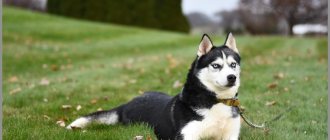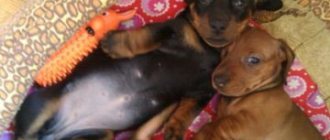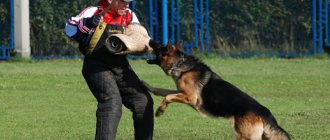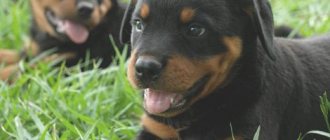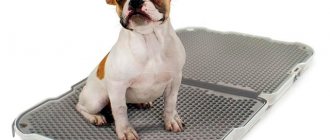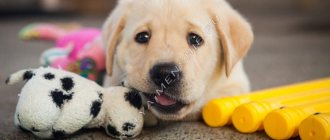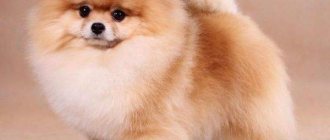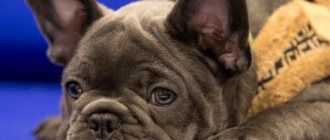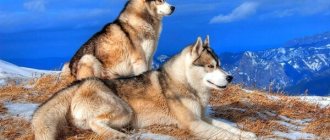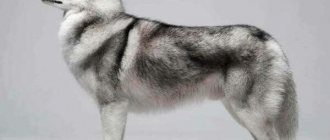History of the Siberian Husky breed
The Siberian Husky is a dog that has been living next to humans for many centuries. It was bred by the indigenous inhabitants of the Russian Far North. The Chukchi desperately needed a dog that could cover long distances and transport people and cargo from seasonal hunting grounds to camps. Harsh climatic conditions had a decisive influence on both the formation of the animal’s structure and its character.
Husky with eyes of different colors (Heterochromia)
The spread of the breed beyond its centuries-old habitat began actively in the 20th century. The husky's endurance, ability to work harmoniously in a harness for a long time and good speed were appreciated on the American continent. Alaskan mushers increasingly began to purchase these dogs to participate in sled dog racing. The greatest fame was gained by Leonard Seppala's team, led by the legendary Togo, which did not give up the palm for several years in a row. But this musher and his dogs entered the history of mankind primarily because it was his Togo, leading a team, who covered a huge part of the path of the famous dog relay of 1925, delivering anti-diphtheria serum to Nome. A small town in Alaska, cut off from the world by miles of snowy desert, is overwhelmed by an epidemic of a deadly disease. It was not possible to get to it quickly and safely by conventional means: unfavorable weather and natural conditions were not suitable for air or land transportation. And then people turned to the faithful huskies for help. The sled relay covered more than a thousand kilometers in a record five days, and the city's population was saved. The best dogs, led by Togo, covered 146 km - the maximum distance. The dogs walked eighty kilometers on the ice of Norton Bay in forty-degree frost in a snowstorm. Such a feat became possible only thanks to the instinct, courage and endurance of the leader of the pack.
The last team in this relay were the dogs of Gunnar Kaasen, led by Balto, who got all the glory. In memory of these events, grateful people erected a monument to this dog in New York. Statues of Togo and Balto greet guests at the entrance to ClevelandMetroparksZoo, and when visiting the museum in the small Alaskan town of Wasilla, you can see Togo's embalmed body. To commemorate that incredible relay, Alaska hosts an annual multi-day sled dog race.
Husky puppy
Further development of the breed took place on the American continent, since in the 30s in the USSR the selection of sled dogs was considered unpromising.
In the USA, for a long time, special attention was paid to the sports component. The crossing of Siberian huskies with native sled dogs of Alaska led to the emergence of mixed breeds, which became much more successful than huskies in racing competitions, although they did not receive recognition from international organizations - the mixed breeds turned out to be very diverse.
A new direction in the history of the breed - exhibition - began from the moment when E. Seely and L. Demidoff first presented a bright black and white dog with blue eyes to the judges. It was since the 70s of the last century that huskies increasingly appeared as a domestic companion dog, quite suitable even for keeping in an apartment.
The return of the breed to its historical homeland, Russia, occurred in the 90s. The first dogs were imported from Belgium and the Czech Republic in 1995, and after five years the number of purebred puppies reached one and a half hundred.
Behavior in the house and apartment
Pets are fussy in enclosed spaces . They can get used to life in the city, but there should be plenty of indoor space. The activity of the breed can be considered a disadvantage, especially if walks are rare and short. The animal will run, chew and damage objects, and howl. This can be weaned off in childhood, although the basis of good behavior is regular physical activity.
Huskies can be annoying and demand attention. If the dog is often left alone, it will become sad, lose interest in life, or become completely uncontrollable.
Siberian Husky breed standard
Today, huskies are divided into three groups - sledding, sporting (racing) and exhibition.
The official breed standard describes a sled dog. To a greater extent, British-bred huskies fall under these criteria.
Dimensions
Siberian Huskies in their element
The Siberian Husky is a medium-sized animal. The height of a dog at the withers is from 54 to 60 cm, of a female – from 51 to 56 cm. The weight of dogs is 21-28 kg and 16-23 kg, respectively. Excessive height is grounds for disqualification. The husky's weight is proportional to his height, the length of the body when viewed from the side is slightly greater than the height at the withers (extension index 110-120).
Head
The skull is small in size, rounded at the back of the head and tapering evenly towards the eyes. The bridge of the nose is smooth, the stop is clearly defined. The muzzle is of medium length, with almost the same distance from the nose to the stop and from it to the back of the head. It tapers evenly to the nose, which should be neither sharp nor square.
Huskies are characterized by a lively and interested, even with a certain amount of mischief, expression on their muzzle.
The disadvantages include:
- a sharply defined and massive head;
- the presence of an unclear transition from the muzzle to the forehead;
- black nose for gray, red and black huskies, and brown for brown dogs;
- muzzle too narrow or too wide.
Eyes
Set slightly obliquely at an average distance from each other, almond-shaped. The color of the iris is brown or blue, mosaic-colored or heterochromic options are allowed.
Disadvantages: eyes that are too close and too slanted.
Husky eyes
Ears
Husky ears are located high on the head at a short distance from each other. They stand firmly, with slightly rounded tips pointing straight up. The ears are medium-sized and triangular in shape.
Disadvantages – the ears are too large (in relation to the size of the head), the tips are directed not upward, but to the sides.
Teeth
A scissor bite is required; any deviation is a fault.
Neck
Husky muzzle
Medium length, raised on a standing animal. When moving, it bends so that the husky's head is slightly forward.
Disadvantages - too thick, as well as excessively long or short neck.
Frame
The chest is strong and deep (huskies have a fairly large heart), the ribs are widely spaced. The back is strong, with a level line from the shoulder blades to the croup. The lumbar region is elastic and tucked.
Disadvantages - too wide chest with barrel-shaped ribs, sagging back, sloping topline from the shoulder blades to the croup.
Tail
In a calm state, the husky's tail is slightly lowered and is located slightly below the line of the back. When the dog is interested or excited, it bends upward in a sickle shape, but curls into a ring, does not roll over its back or curl to the side. The coat has approximately the same length, which is why the husky's tail resembles a round fox's.
Disadvantages - too low or, on the contrary, too high, tightly curled tail.
Limbs
Brown Husky
The front ones are straight and parallel, located at a moderate distance from each other. The elbows are pressed to the body, turning neither in nor out. The bone is not heavy, but strong.
The hindquarters are parallel, moderately spaced. The knee joints are mobile, hock, have clearly defined angles and are located close to the ground.
Vestigial digits on both the front and hind legs must be removed.
Disadvantages: cow-like hindquarters, elbows turned outward, heavy large bone.
Paws
Husky paws are medium in size, oval, but not elongated. Well furred between the pads of the toes. The pads are thick-skinned. When the dog is at rest, its paws do not turn to the sides.
Disadvantages: clumsy or, conversely, too small paws, flat toes.
Wool
The husky's coat is of medium length, which, creating the effect of good furring, does not interfere with viewing the lines of the body. The undercoat is soft and dense. The outer coats are straight and smooth, but in no case coarse or erect.
Disadvantages: shaggy, hard coat.
Color ranges from pure white to black. There are white mask-like markings on the head, characteristic only of huskies.
Photos of adult huskies
Features of walking without a leash
The breed is northern, bred for persistent hard work, transporting goods and people over long distances. Therefore, when going outside, the animal feels free. Huskies love to run a lot and for a long time, they are curious and rarely obedient, so they often get lost and run away. A weak and slow person will not be able to hold and later catch up with the dog. Many owners keep their pets off a leash to avoid such situations, although this breed needs free runs.
Very often, city authorities prohibit walking medium and large dogs without muzzles and leashes. In this case, the pet must be taken outside the populated area: to the river, to the landing, to the lake, avoiding public crowded places.
Dog handlers recommend teaching your Husky a leash from the first walks and not letting him go in urban environments until he is completely submissive, where the dog can get lost or get hit by a car. The animal needs to know all the commands and be able to carry them out under any conditions. Although this breed is difficult to train to obedience.
Character of the Siberian Husky
Friendliness, liveliness of mind and calm disposition are the main properties of the Siberian Husky. But, speaking about these wonderful dogs, I would not like to limit myself to such a short list.
Ready for the New Year!
The ancestors of modern animals, who faithfully served man for many centuries in the harsh conditions of the Far North, passed on to their descendants all the variety of distinctive character traits and behavior that so attract connoisseurs of this breed today.
Huskies, like true sled dogs, are very active and need good, constant exercise.
Representatives of this breed are not suitable for hunting enthusiasts, despite the presence of a fairly strong instinct. For the Siberian Husky, such hunting is one of the ways of subsistence, and it will not share the prey (the dogs were fed only in winter; the rest of the time the team was grazing).
These northern dogs are pack animals, which has led to almost complete elimination of the instinct to protect their own territory, so such pets are completely unsuitable for the role of a guard. The lack of aggression towards humans, even strangers, also does not allow these dogs to be classified as guard dogs. Attempts to embitter the dog can only lead to permanent mental disorders of the animal. Nature has endowed these amazing dogs with well-developed intelligence and the ability to make independent and often extraordinary decisions. Hence the difficulties that arise during training, when certain commands require a template algorithm of actions from the husky. The use of representatives of the breed as service animals is not practiced.
The Siberian Husky is a companion dog. She is perfect for a large family; she will tenderly and reverently love all members of the household, although she recognizes only one as the leader and master. The attitude of these animals towards children deserves special attention. It is difficult to find a more gentle, attentive and affectionate friend for a child. Suffice it to recall that the Eskimos even used huskies to warm newly born babies.
One of the unusual character traits for dogs is the animal's tendency to run away. A door latch or cap hook will not become an obstacle - understanding the principle of their operation for a pet is a matter of a few days. Digging a hole under a fence, and if necessary, overcoming a high barrier is also not a problem. No one claims that your dog will systematically engage in such pranks, but you should still not forget about this feature of the husky.
Siberian Huskies in harness
Advantages and disadvantages
Siberians have many fans, as the breed has many advantages. They differ in many qualities from other relatives.
Positive features:
- friendliness;
- sociability;
- love for children;
- beauty;
- mind;
- rich wool;
- frost resistance;
- strong immunity;
- life expectancy.
The appearance is not without its shortcomings.
Minuses:
- stubbornness;
- cunning;
- craving for hunting yard animals;
- tendency to run away;
- cannot stand loneliness;
- does not obey weak people.
With proper upbringing of the dog, the proportions of pros and cons can be changed, eradicating bad qualities.
Education and training
When it comes to raising and training a Siberian Husky, it is important to consider that these dogs are working dogs by nature, but not service dogs. Experts consider representatives of the breed to be good and easy to train animals. But they will obey only a recognized leader and owner - you must become an indisputable authority for the pet.
Raising a puppy should be based on two main principles - rigor and fairness. The carrot and stick policy is unacceptable. An overly gentle attitude will spoil the baby and he will “sit on your head”; cruelty will embitter the animal, which will definitely take revenge on you if necessary.
You can start training and training your dog from the age of three months. The Siberian Husky is very intelligent, and if you fail to interest him, it will be difficult to achieve results. And not because the animal does not understand you - no, he is simply not interested. The greatest effect is achieved by the training process in the form of a game. These dogs are very sensitive to the manner in which commands are given, so correct intonation is very important. You must speak calmly, confidently and clearly. Although at the same time, many owners of dogs of this breed note that huskies respond better to requests than to orders. In any case, every owner is looking for his own way to the heart and mind of his pet.
Raising any dog is impossible without a system of rewards and punishments. There are several husky misbehaviors that should be stopped immediately:
- aggressive behavior towards the owner;
- unreasonable hostility towards other dogs;
- actions that could harm the animal itself.
The best method of punishment for a Siberian Husky is to demonstrate its strength and advantage. To do this, simply grab the animal by the withers, press it to the floor and hold it until the dog stops resisting and becomes quiet. Beating as a method of education is unacceptable.
It's easier with incentives. Always praise your dog for every correct action. If you are working with a puppy, praise can be reinforced with a piece of treat. The intonation should be different from the tone in which you give commands, but do not show unnecessary emotions - huskies cannot stand high, shrill intonations.
Puppy. Come, new home.
So, you have chosen a puppy and the time has come to pick him up and bring him to his new home. The breeder will definitely tell you at what age it is best to pick him up. Here opinions differ, some believe that the puppy should be adopted as early as possible, at the age of 6 weeks, suggesting that this will provide a better chance for early socialization and adaptation to the new environment. Most people think that 6 weeks is too early, especially for pack animals that have to learn too much of their behavior from their mother. The transport process itself can be very stressful for the puppy, but most Siberian Huskies tolerate travel in cars well. Perhaps the breeder by this age has already taken the puppies once or twice for vaccination or simply to accustom them to a car; in this case, the puppy will be less stressed. If you are taking your puppy alone, you will need to take a crate for his safety.
Where to start training a puppy
1. Recognizing your own nickname. The methods are quite simple. Call his name when you call your pet to a bowl of food, and after the baby wakes up, gently stroke him, saying his name. The results will not keep you waiting.
Dad with two puppies
2. Husky, as a pack dog, needs a leader, so from the first hours of being in your home, let it understand who is in charge. Moreover, be careful - even when communicating with members of your family, you must behave as an unquestioned authority, and the puppy must see this. The husky is very smart and will immediately sense if you give in to “slack” in relations with other members of the pack, and the dog perceives all household members this way.
3. Execution of the simplest commands: “Nearby!” and “Come to me!” achieved by the traditional method - with the help of tasty treats and praise.
Many owners are concerned about what to do in cases where the puppy reacts violently to strangers coming into the house: it behaves annoyingly, gets underfoot, begs for food. There is only one answer - ignore it. Don’t stroke, don’t admire (the husky is just waiting for this), but simply don’t notice. The method works flawlessly. The dog, realizing that no one is interested in him, will very soon leave for his place.
Among the general recommendations for raising and training a Siberian Husky, the following can be highlighted:
- do not forbid your pet to communicate with other dogs;
- do not pick up the dog, especially holding it belly first;
- do not tire your husky by performing the same command many times in a row;
- respect your friend and treat him fairly.
Relationship with the owner
A dog can have different relationships with its owner:
- The most common and correct model is the leadership of the owner and the obedience of the pet. If the Husky understands that a person is a leader, then he will obey him. This can be achieved through long-term training.
- Another acceptable model of relationships is fraternal. When the dog and the owner live and work on equal terms: they share food, bed, house, work together, performing their functions. Then the pet will consider the person an equal and obey him as a partner.
Two wrong parenting options: an idol dog and a rad dog. In the first case, the family exalts the pet over its own needs, which is why the Husky becomes uncontrollable. In the second, the animal is abused, which destroys its psyche.
Care and maintenance
When purchasing a husky puppy, you must remember that these Siberians simply cannot stay in a limited space for a long time. Any attempt to turn your pet into a “couch” dog is doomed to failure. Movement, active games, good physical activity, long walks - these are the elements of these magnificent animals.
Husky on a leash
In order for the energy of a dog, especially one living in an apartment, to be directed in the right direction, experts of the breed recommend loading the Siberian Husky to the fullest. Otherwise, the comfort of your home may be seriously damaged. One of the options may be to keep the dog in a cage. Accustomed to this state of affairs from an early age, the husky will react to this quite calmly. Another thing is that for a loving owner, the sight of a friend sitting behind bars will not evoke positive emotions at all, so the best way out still seems to be to “load” the pet to such an extent that he simply does not have the strength for domestic pranks.
Maintenance in a country house also has its own characteristics. Remember that huskies are dogs from harsh regions, and being on the street is not a burden for them. Many owners note that even in severe frosts, animals rest and sleep in the snow, and not in a booth - the spirit of the Arctic reminds of itself.
Be sure to provide your pet with a spacious enclosure. Just don’t use chain-link for this: in a matter of days, the Siberian Husky will turn it into hanging rags. For fencing, use wire at least half a millimeter thick. It is better to lay the floor with natural stone, because these dogs are great experts in digging and will not fail to demonstrate their talent in this matter. If you think that an enclosure is unnecessary, make sure that the fence of your area is a reliable barrier in the way of the husky in his desire to explore and travel far.
The best thing is to find time to take your dog for much-needed walks.
What do you need to purchase before bringing your pet into your home? First of all, these are a couple of bowls for water and food, special “chew” toys, and a rug on which your friend will rest. A little later you will need to buy equipment such as a collar, leash and muzzle. A halter can also come in handy - with its help, even a child can control a Siberian Husky.
Description
Like all types of northern breeds, huskies are tall, stately dogs with rich colors, strong muscles, and an easygoing disposition. Representatives of the species are among the 10 most beautiful, intelligent animals in the world.
When forming the rating, experts took into account the physical characteristics of individuals, appearance, and intellectual development. The dogs scored high in all positions. Experts are convinced that huskies are real thinkers. They can correctly assess what is happening and make informed decisions.
This is interesting: What is the difference between a Siberian Husky and a Laika?
Varieties of colors
The official all-Russian list of husky coat colors includes about 5 shades. In fact, there are over 10 of them.
There are no individuals with the same hair color. Each Siberian Husky's color is unique.
Wool shade options:
| Color | Characteristic |
| Snow-white | It is extremely rare. Interspersed with other tones are not allowed. The combination of an animal’s white coat with blue eyes looks especially attractive. |
| Carbonic | The individuals are called Afrohuskies. Purebred breeds do not have this shade. In the total mass of dark hair, light spots are acceptable |
| Black and white | Usually white color predominates. The combination looks impressive |
| Grey | Ash tone is the base. Silvery, fawn undercoat. This is a common option. These huskies are called wolves because of their strong resemblance to wild animals. |
| Silver | The fluff is white. The main coat is grey. The play of shades creates a shimmering, glowing effect |
| Ginger | A catchy version of the color scheme of Siberian dogs. An orange coat makes your pet look like a fox |
| Pale yellow | Red (but not intense), turning into cream tones |
| Copper | Chocolate variant of wool, which is often confused with fox |
| Piebald | Other names: pinto, pibold. The body of the dogs is white with colored spots of different sizes. Nose, eye rims – brown or black |
| Black and tan | Charcoal with peach splashes is a rare species, popularly called tricolor. |
| Agouti | Combination of black, red, white colors. The hairs at the roots are light, and at the ends they are rich. Animals with a mixture of such shades are rare |
| Splash coat | Reminds me of a variety of piebolds. Distinguished by the presence of a light collar on the neck |
| Saddled | There is a spot on the back of the animal that resembles a saddle. Saddle cloth comes in different tones |
| Sable | One of the most beautiful suit options. Chocolate, fox, brown - basic colors |
| Marble | Looks original. Wide range of colors, unevenly distributed throughout the body. Main tone – white |
| Isabella | Game of fawn and red colors |
Not only the fur, but also the eyes of the Siberian Husky are distinguished by a variety of shades.
This is interesting: Puppies from a cross between a shepherd and a husky
Iris color:
- brown;
- amber;
- green;
- blue;
- heterochromic.
Of particular interest to dog breeders are dogs with different eye colors, as harlequins are believed to bring good luck.
Behavior and skills
In order for a husky to behave impeccably and be in complete submission to its owner, the owner must explain to the pet who is boss in the house. Representatives of the breed are inventive and capable of outwitting humans. Such attempts must be stopped.
Expert opinion
Anna Abramenko
An avid dog lover. Experience in veterinary medicine since 2009.
Ask a Question
Dogs rarely bark. When left alone, they can begin to howl in sadness. By nature, they tend to live in groups. They love to dig holes. Therefore, it is better to show your pet a place where this is allowed.
Husky easily gets along with other breeds. But cats and birds cause irritation. The dog is capable of attacking them. It's important not to let him do this.
Animals don't like hot weather. Thick wool heats up quickly. Therefore, you should not allow your pet to remain in the sun for a long time.
Modern huskies are rarely used to carry cargo. Sporty driving is a priority. The dogs easily pull the sleigh through the snowdrifts. Average running speed is 35 km/h.
What makes the breed hardy is its flexible metabolism. The metabolism of its representatives is manageable. If necessary, it can speed up or slow down.
Huskies are also capable of mastering the most complex commands. Learn quickly at any age. But making them ideal guards is difficult.
What and how to feed huskies
Until the age of two months, the puppy is fed 6 times a day, up to 4 months - five, up to six months - four, then - three times a day. From ten months onwards, it will be enough for a Siberian Husky to eat twice, and an adult animal (over one and a half years old), depending on physical activity, eats once or twice a day.
Most experts agree that it is better to feed your four-legged friend dry food and special canned food. These must be premium and super-premium products. Cheap food contains a high content of starch, which is not very beneficial for these northern dogs.
You can immediately see who was visiting grandma
Until the animal reaches 10 months of age, “puppy” food will be sufficient for normal development; for adult huskies, balanced food for breeds with high physical activity should be used.
Even when using the highest quality feed mixtures, breeders recommend carefully monitoring the dog’s condition in order to make timely adjustments to the menu if necessary.
Organizing a husky’s proper nutrition with natural products is somewhat more difficult. Up to 60% of the diet should be meat (raw or slightly scalded). The best choice - beef, rabbit and turkey - are possible, it is better not to mess with chicken due to the high risk of allergic reactions, pork and lamb should be completely excluded. Eggs, or rather boiled and raw egg yolks, can be added to porridge a couple of times a week; vegetables, with the exception of potatoes, are also healthy. It is better to give dairy products only in their sour versions. Don't forget to add a little vegetable oil and fish oil to the food.
No matter how varied you feed your Siberian Husky, you cannot do without vitamin supplements. Your veterinarian will tell you about their correct use.
Pet hygiene comes down mainly to coat care, especially during shedding, as well as monitoring the condition of the teeth. To keep them white and smooth, clean the stone and plaque in a timely manner. This can be done both at home and in the clinic.
But huskies do not need bathing. Their fur is capable of self-cleaning, and this dog does not have a “dog spirit”. It is water procedures that provoke the appearance of an unpleasant odor, which can lead to disruption of the fat balance of the skin and coat.
Proper care and maintenance is the key to your friend’s well-being and longevity.
Advantages of the breed
The owner determines the merits for himself, because all dogs are individual and differ in character. The main advantages of the breed are highlighted:
- Friendliness, positivity, affability;
- Openness, sociability, contact;
- Good intellectual abilities;
- Good relationships with relatives;
- Huskies rarely bark;
- There is no specific dog smell;
- Not aggressive;
- Mobility (remain active until old age);
- Dogs do not need large amounts of food;
- Strong immunity, endurance to cold and work.
Health and disease of the Siberian Husky
As a true child of high northern latitudes, the Siberian Husky is distinguished by good health.
However, this does not mean that the owner should not monitor the condition of his pet. When purchasing a puppy, study the pedigree of its parents and check if there were any genetically transmitted diseases in its family. For dogs of this breed, most often these may be diabetes mellitus or problems with the thyroid gland, some eye diseases (glaucoma, corneal dystrophy, cataracts), and hip dysplasia. Sometimes Siberian Huskies suffer from epilepsy. This disease cannot be completely cured, but proper care will reduce the number of attacks. Timely and complete vaccination and careful monitoring of the dog’s condition will help avoid the occurrence of most health-related problems.
It is recommended to periodically examine the animal’s ears, eyes and teeth, and monitor the condition of its fur. Don't ignore your husky's gait. Lameness can be the result of either muscle damage or incipient problems with the musculoskeletal system.
Monitor your dog's weight. Both obesity and wasting are equally harmful.
Timely deworming is very important for the Siberian Husky, especially considering the tendency of dogs of this breed to eat feces (any attempts should be strictly suppressed).
Keeping in mind the northern origin, during summer walks try to choose the coolest and shady places.
If you experience any signs of discomfort, you should immediately contact your veterinarian.
With good care and proper maintenance, the life expectancy of a husky can be more than 15 years.
Huskies love sausages
Photo and video review
Husky is a wise dog with a high ability to learn. You can verify this by reading information about the breed and looking at sketches with the participation of a Siberian.
The undeniable dignity of the dog is confirmed by photographs.
How to choose a puppy
The main rule is that you can only buy a baby in specialized nurseries or from well-known breeders. This will give you much more guarantee that the grown animal will fully comply with breed standards and be in good health. Buying a husky puppy online or on the market is completely out of the question. Even if they really offer you a purebred baby, how can you check in what conditions the dog was kept, what the puppy, as well as its parents, were fed? No one can guarantee you correct and timely vaccination. And these are all the components of your pet’s future health.
Purchasing a Husky puppy from a breeder or kennel has other benefits. Firstly, you get the opportunity to directly communicate with all the puppies of the litter, evaluate their character, temperament and intelligence. Secondly, gain a lot of important information about the behavioral characteristics of animals, their diet, and habits. An experienced and responsible breeder will definitely answer all your questions, ask why you chose a Siberian Husky, and give practical advice on care and maintenance. Thirdly, a puppy from a nursery or from a recognized breeder must have all the necessary accompanying documents, from a pedigree to a veterinary record with data on vaccinations and deworming.
A Siberian Husky puppy can be taken home at approximately two months of age. Try to meet your baby as often as possible, walk and play with him. Many breeders recommend taking an older animal - the dog already has some skills and is more disciplined, and the new owner will simply have a little less educational tasks at first.
It will also be useful to know that each husky raised in a kennel has its own brand. It is usually placed on the inside of the dog's ear or on the dog's belly.
How to train: what you need to know
- Husky is a working breed with a strong character. Boys try to dominate, girls are less inclined to lead, but in both cases they cannot be raised like sofa dogs, to indulge every whim. The owner must be a leader and constantly prove it. Do not succumb to the student’s tricks, persistently achieve the fulfillment of commands.
- Not suitable as a first pet. The owner of a husky must have knowledge and experience in training, and be self-confident. Professional trainers at our center will give advice on the proper training of dogs of any age and show how to conduct lessons.
- Teach useful skills gradually, without pressure. Play with your pet, communicate, become the “center of the universe” for him and he will obey you unquestioningly.
- The dog needs daily physical and mental exercise, otherwise it will direct its energy towards destruction. Recommended training courses: controlled city dog, obedience.
- Sled racing is the best use for the breed. Beginning of training (from 2 months) - accustoming to a harness and equipment. Wear them for a short time in the apartment or on a walk so that the puppy gets used to it quickly. Training a husky at home should consist of developing basic commands, without which interaction between the musher and the runner is impossible - forward, stop, right, left, past, impossible. From 10-11 months, he can pull a skier, provided that he skis well and only a small part of the weight rests on the dog. The first serious load is at the age of one year, when the bones become stronger. If you cannot put your pet in a harness, practice riding skills on walks - start teaching him with canicross or towing a tire. In Moscow, not all parks allow dogs, so it’s better to go outside the city where there is space for exercise.
- At temperatures above +16 degrees, it is advisable not to carry out training with loads. Warm weather can have a negative impact on your Husky's health.
Other articles:
- Exhibitions, ranks, titles, certificates, diplomas
- How to train pug dogs
Return to list
Photos of Siberian Husky puppies
Health
The average life expectancy of a husky is 12 years.
When properly bred, these are very healthy dogs, but, like any breed, they have their “weak points”: dysplasia and cataracts. The correct selection of breeding pairs allows you to minimize the risk, however, unfortunately, not all breeders work correctly. The situation is aggravated by the fact that huskies have become fashionable, and the demand for them is very high, which means there is a huge temptation and ample opportunities for unscrupulous breeders. Carefully study the Husky breed standard before purchasing.
It’s good if parents have marks about testing their parents for genetic diseases, but this is still rare in Belarus.
How to choose a husky puppy?
When choosing a puppy, pay attention to the reputation of the breeder. If possible, meet those who have already taken puppies from this nursery - how happy they are.
Find out what vaccinations you have received. But keep in mind that a puppy up to 3 months cannot receive all vaccinations - vaccination cannot begin earlier than 45 days and sometimes takes up to 5 months. So if you are adopting a younger puppy, the remaining vaccinations will be your responsibility.
Breeder's recommendation: Assess the condition of the parents. The saying “the apple doesn’t fall far from the tree” is also true when it comes to dogs. If you are greeted by 7 adorable babies, but the mother looks exhausted and unhealthy, a miracle will not happen.
If you take a puppy without documents, it's basically a Pandora's box. Perhaps these are not huskies at all, but mestizos. The pedigree gives you at least a guarantee that this is a purebred puppy. Yes, it does not guarantee victories at the World Championships, but at least you will get the breed you paid for.
The puppy should be well-fed, active, and without a bloated belly.
Pay attention to the content. The room should be clean and there should be no unpleasant odor. A self-respecting breeder will never allow the dog’s “house” to stink or for the puppies to live in dirt.
Be sure to draw up a purchase and sale agreement with the breeder.
How much does a Siberian Husky cost?
There are several factors that influence the cost of husky puppies.
This includes the presence of a pedigree, the individual qualities of the baby (appearance, physical fitness, gender), and the status of the parents. It is clear that the cubs of champion dogs - in the case of huskies, not only for exhibitions, but also for sports competitions - will cost much more than the babies of ordinary parents. If you just want to have a friend at home and don’t bother with a show career, your choice is a pet-class puppy. It will cost 20-25 thousand rubles. Most likely, it will be sold without a pedigree, but will that stop you?
Breed-class dogs already cost from 30 thousand rubles. They have all the necessary documents and are quite suitable for breeding work. Some minor deviations from the breed standard are possible.
The most expensive are show class puppies. Such animals fully comply with official standards, have no flaws and are born husky champions. The price for a dog of this class can be more than 60,000 rubles. Buying a baby without the advice and help of an experienced breed expert will be very problematic.
When planning to buy a Siberian Husky, do not chase the low price. On the contrary, such a proposal should alert you. Most likely, ordinary deception or dishonesty is taking place. A husky puppy, taking into account the costs the breeder incurs when breeding this breed, simply cannot be cheap.
Male or female.
Who do you want to buy - a male or a female? This is purely an individual preference. Any discussion about the advantages of one sex over the other is meaningless, this should be remembered.
Males are larger and stronger, so they can be much more difficult to keep on a leash. Bitches are more “flirtatious” with their brothers, they have a more developed hunting instinct. Naturally, there are individual options for each gender; puppies can be affectionate and enjoy your attention, and will rather wait for you to come to them than seek your company themselves.
Bitches are in heat, and males love to put their paws on other people's cars, which will annoy your neighbors.
Attitude towards children
The dog gets along with children of all ages and loves to nurse and play with them. The best example of the interaction between a child and a husky is the birth of a baby among the Eskimos. During this period, all dogs are allowed to move into the home to keep the newborn warm.
Huskies are devoid of aggression, incredibly smart and understand the boundaries of what is permitted. A Siberian dog can harm a baby only by accidentally stepping on or touching it. If there are no experienced dog owners in the family, get a Husky only when you have the time and desire to train your child and dog to interact successfully.
What's a cool name for a boy's dog?
Baron, Bonya, Bim, Buddy, Butch, Barney, Bonnie, Beck, Bob, Byron, Bima, Blade, Barbos, Burton, Boy, Butch, Brawler, Boston, Buster, Bingo, Boss, Boomer, Bart, Bond, Buckler, Billy, Bobby, Basta, Blade, Brian, Bernard, Bice, Benya, Bucephalus, Bike, Bilbo, Betmer, Beckham, Golden Eagle, Baggio, Brandy, Burke, Benedict.
Interesting materials:
What are soft wheat varieties? What are deli meats? What is Microsoft Visual C Redis? What is Middle Name in English? What are mycorrhiza examples? What is a micro SD adapter? What is Mixed Sound? What is a mini cruiser? What is the world of ideas and the world of things in Plato's philosophy? What is a 2nd class multiplier?
